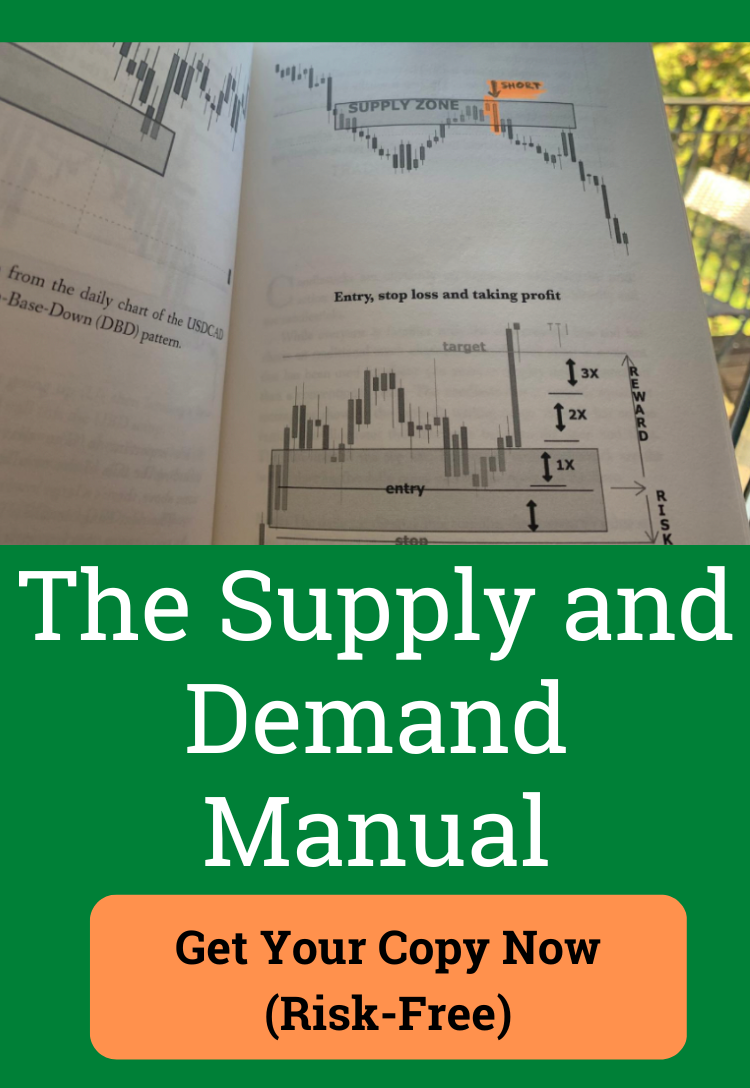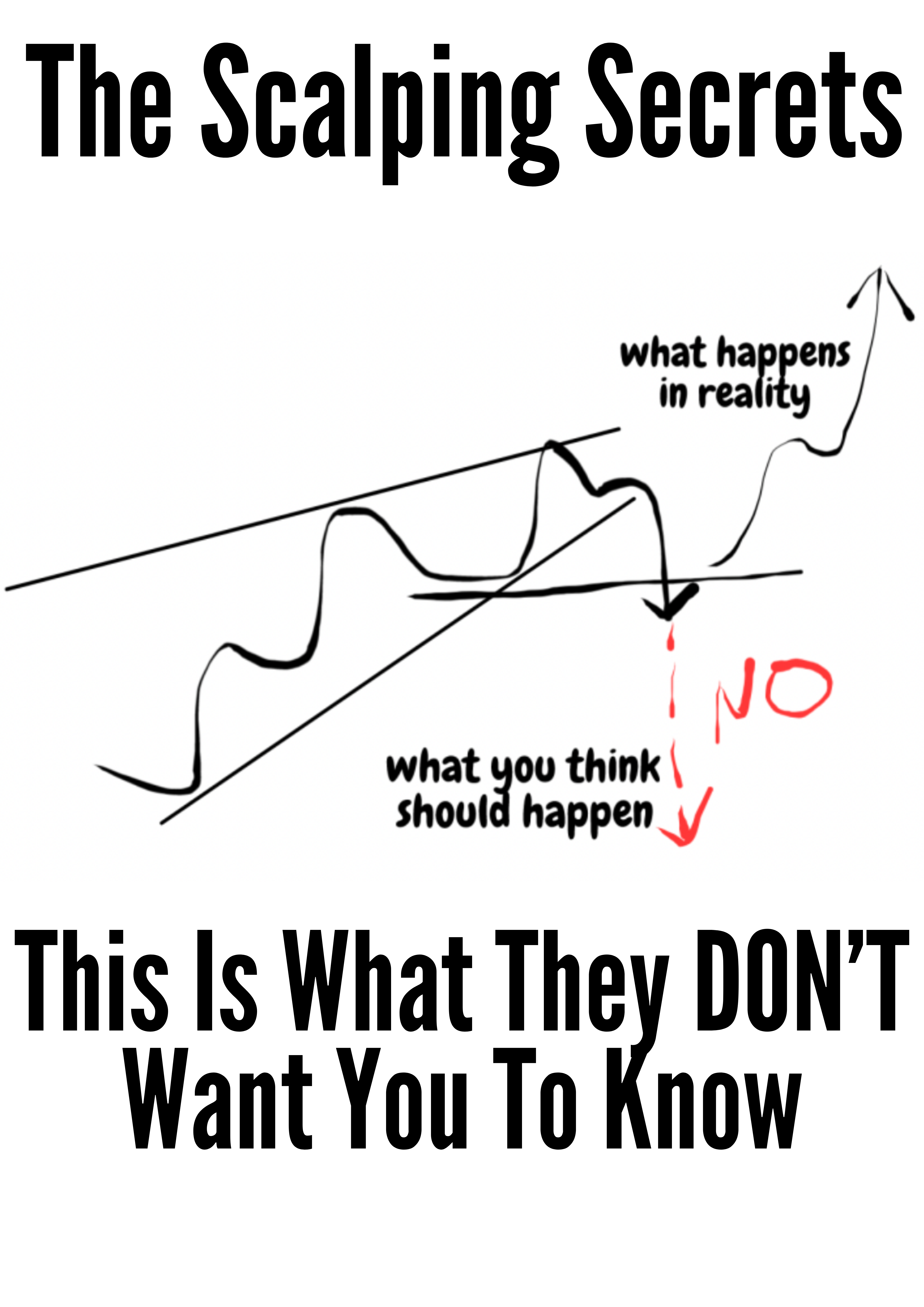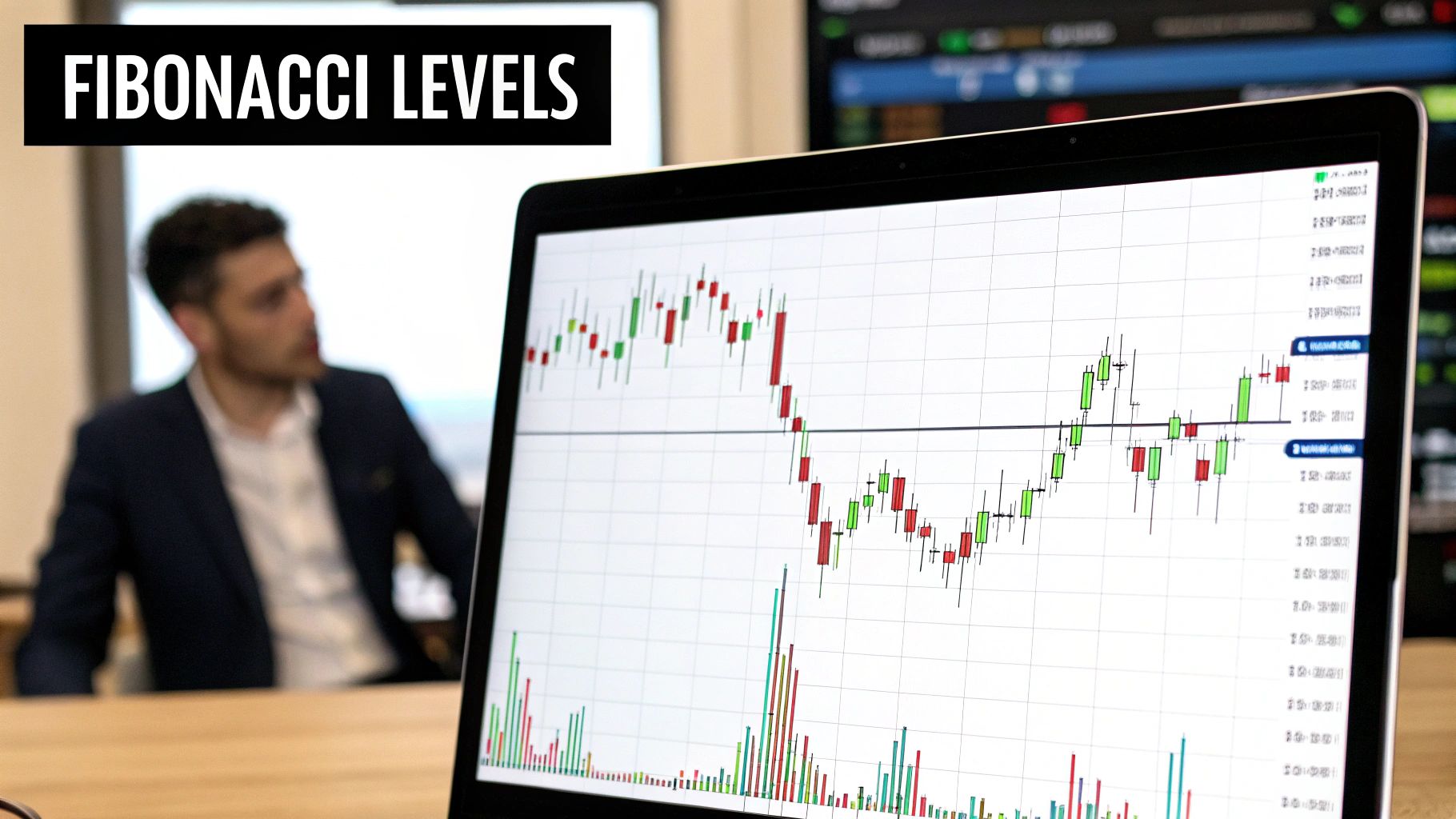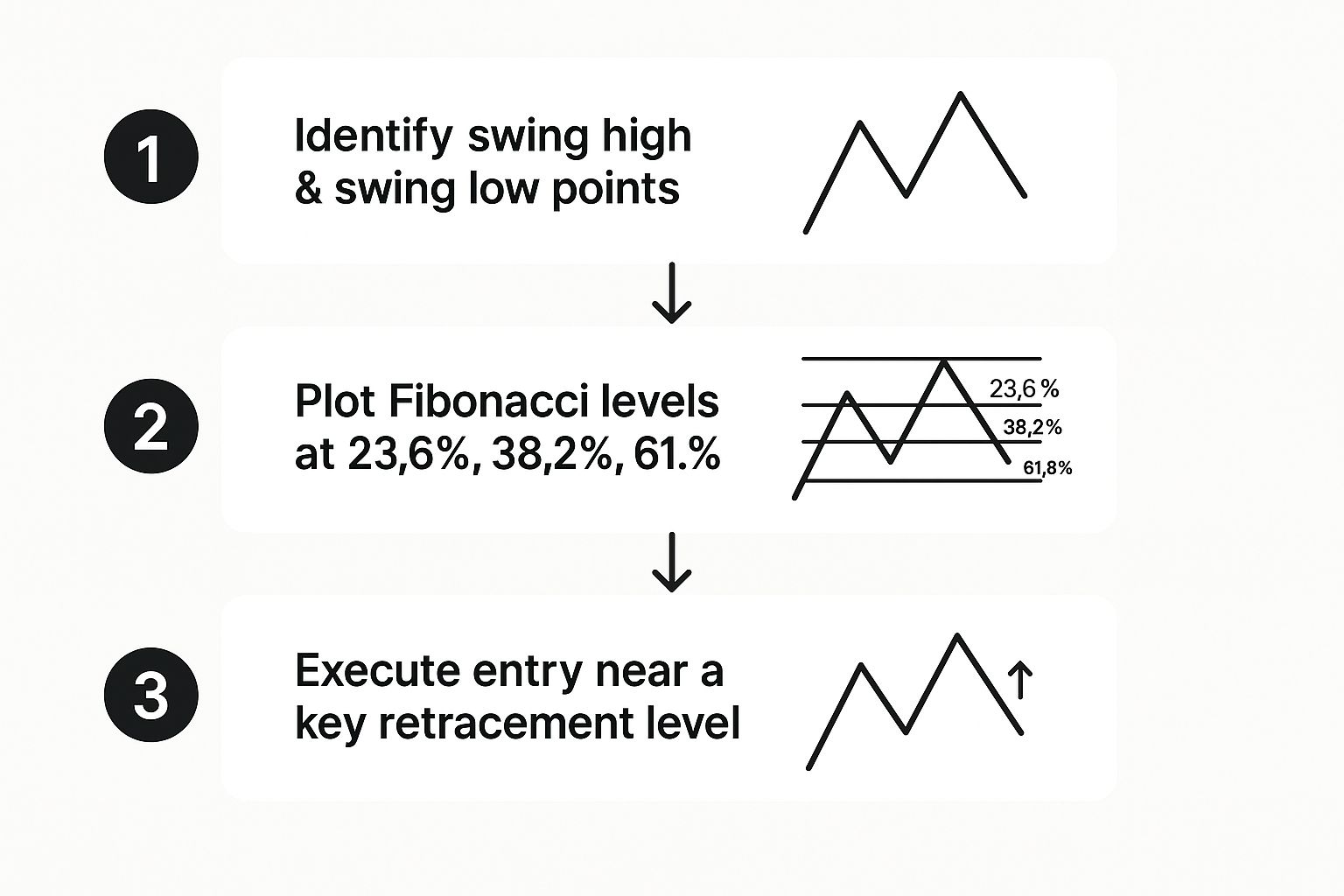How to Draw Fibonacci Retracement: Complete Trading Guide
Understanding Why Fibonacci Retracement Actually Works
Let's explore the popular trading tool known as Fibonacci retracement. This technique, based on a mathematical sequence discovered by Leonardo Fibonacci in the 13th century, is a key element of technical analysis. But what makes it tick? It's a fascinating combination of mathematics, market psychology, and self-fulfilling prophecy.
The sequence, where each number is the sum of the previous two (like 0, 1, 1, 2, 3, 5), creates specific ratios found surprisingly often in nature. These ratios, applied to financial markets, often act as potential support and resistance levels. This means that during a price trend, assets often pull back or "retrace" part of the initial move before continuing in the original direction.
These retracements often align with Fibonacci ratios. Common retracement levels include 23.6%, 38.2%, 50%, 61.8%, and 78.6%. These percentages are calculated from ratios within the Fibonacci sequence, resulting in important levels like 0.382, 0.5, and 0.618, commonly used in technical analysis. Explore this topic further
The Psychology Behind the Numbers
Fibonacci retracement's effectiveness is boosted because millions of traders watch these same levels. This creates a self-fulfilling prophecy. When many traders anticipate support or resistance at a specific Fibonacci level, their actions (buying or selling) can influence the price at that level.
Institutional Influence
The impact of Fibonacci levels extends beyond individual traders. Large banks, hedge funds, and other institutional investors often use these ratios in their algorithms and trading strategies. This increases the importance of these levels, as large orders placed near these percentages can cause substantial price swings.
Why Certain Percentages Are More Powerful
Not every Fibonacci level has the same strength. The 38.2% and 61.8% levels are usually seen as stronger and more reliable than others. This is because of the "golden ratio" (about 1.618) from the Fibonacci sequence, considered a harmonious proportion. This ratio and its inverse (0.618) show up in nature and are believed to be aesthetically pleasing, potentially influencing trader psychology.
The 50% retracement level, although not directly from the Fibonacci sequence, is widely recognized as psychologically significant. Traders often view a 50% pullback as a potential turning point, increasing buying or selling pressure. This combination of mathematics and market psychology makes Fibonacci retracement a lasting trading tool. By understanding the importance of these levels, traders can anticipate potential turning points and make informed decisions.
Setting Up Your Charts For Precision Analysis
Before you begin using Fibonacci retracements, it’s essential to have your charts set up correctly. This is a critical step that can significantly impact your trading success. This section covers the ideal chart settings for various trading approaches, helping you achieve the most accurate analysis.
Choosing The Right Timeframe
The timeframe you select plays a crucial role in the precision and effectiveness of your Fibonacci retracement analysis. Different trading styles benefit from different timeframes. A day trader, for instance, might use a 5-minute or 15-minute chart to capture intraday price swings and capitalize on short-term movements.
Swing traders, holding positions for several days or weeks, may find a 4-hour or daily chart more suitable. This broader view filters out the "noise" of short-term price fluctuations, focusing on larger, more significant price swings. Meanwhile, position traders with longer-term investment horizons often analyze weekly or monthly charts to identify major market trends and potential long-term reversals.
Optimizing Your Trading Platform
Different trading platforms like MetaTrader MetaTrader and TradingView TradingView offer various Fibonacci retracement tools, each with its own features. Understanding how to use these tools effectively on your chosen platform is essential.
Most platforms involve selecting the Fibonacci tool and clicking two significant swing points (a high and a low). The software automatically plots the Fibonacci levels between these points. Some platforms allow for more advanced customization, such as changing the color and thickness of the lines or adding custom Fibonacci levels.
To help illustrate the differences in Fibonacci tools across various platforms, let's take a look at the following comparison:
Trading Platform Fibonacci Tool Comparison
Comparison of Fibonacci retracement tools across major trading platforms including features, customization options, and ease of use
| Platform | Fibonacci Tools | Customization | Mobile Access | Cost |
|---|---|---|---|---|
| MetaTrader 4/5 | Standard, Retracement, Expansion, Arcs, Fan, Time Zones | Color, Line Thickness, Custom Levels | Yes | Varies by Broker |
| TradingView | Standard, Retracement, Expansion, Arcs, Fan, Time Zones | Color, Line Thickness, Custom Levels, Alerts | Yes | Subscription Based |
| Thinkorswim | Standard, Retracement, Expansion, Arcs, Fan, Time Zones | Extensive customization options including studies and indicators | Yes | Commission Based |
This table highlights some key differences in customization and cost across platforms. It's important to research each platform's specific features to determine the best fit for your trading needs. Choosing a platform that offers the level of customization and mobile access you require can significantly improve your trading workflow.
Customizing Your Chart For Clarity
Customizing your chart settings, beyond the basic Fibonacci tool, can dramatically enhance your analysis. Make the Fibonacci levels visually distinct to facilitate quick and informed trading decisions. Clear candlestick settings are crucial. Choose colors that contrast well with the chart background and Fibonacci lines.
Many traders use green for bullish candles and red for bearish candles, providing clear visual cues. Adjusting the grid configuration can also make Fibonacci levels stand out. A light grid provides structure without obscuring price action or the Fibonacci levels.
Mastering The Art Of Visual Analysis
Finally, consider your chart's color scheme. While personal preference matters, choose colors that improve visual clarity. A dark background with light-colored candles and Fibonacci lines can reduce eye strain during long trading sessions. Experiment with different settings to find what works best. The best chart setup helps you identify high-probability trading setups quickly and accurately, leading to more informed decisions.
Optimizing your workspace also improves efficiency. Multiple monitors can display numerous charts simultaneously, providing a broader market overview. Using hotkeys for frequently used drawing tools saves time in fast-moving market conditions.
Mastering Swing Point Identification Like A Pro
Drawing accurate Fibonacci retracements relies heavily on correctly identifying swing points. These are the market's swing highs and lows. Unfortunately, this is where many traders stumble, often mistaking minor price fluctuations for significant shifts. This results in inaccurate Fibonacci levels and, ultimately, unsuccessful trades.
This isn't entirely the trader's fault. Many educational resources simply gloss over the essential skill of swing point identification.
Understanding Market Structure
Identifying true swing points requires a strong grasp of market structure. This involves analyzing price action on multiple timeframes. The goal is to pinpoint the underlying trends and patterns. A swing high isn't just the highest point on a chart. It's a point where the price reverses from an upward trend to a downward one.
Similarly, a swing low marks a reversal from a downtrend to an uptrend. These points form the foundation for your Fibonacci retracement tool.
Volume Confirmation: Separating the Real From the Fake
Volume confirmation is one key method for validating swing points. A true swing high often appears with high trading volume. This suggests strong selling pressure. Conversely, a valid swing low frequently forms on high volume, indicating significant buying activity.
If a potential swing point doesn't have corresponding volume, it might be a head fake. This is just a temporary price blip that doesn't indicate a real trend reversal.
Different Sessions, Different Patterns
The timing of market sessions plays a role in swing point patterns. For instance, the Asian, European, and New York sessions all have unique characteristics. Asian sessions tend to be calmer, while the European and New York sessions often see larger price swings.
Understanding these session-specific patterns can help you accurately identify real swing points. It also helps you avoid being fooled by intra-session volatility. This is akin to researchers organizing their notes – a structured approach leads to better accuracy and efficiency. Studies show academics with systematic note-taking methods spend 40% less time reviewing literature and cite 35% more sources. Learn more about efficient literature reviews here.
Multi-Timeframe Analysis: The Institutional View
Multi-timeframe analysis is vital for grasping the institutional perspective. Examining higher timeframes (like daily or weekly charts) gives you a wider view of market structure. This also helps you identify major swing points that institutional traders are likely monitoring.
These higher timeframe swing points tend to be more reliable than those on lower timeframes (like 15-minute or hourly charts). This broader perspective helps filter out short-term price fluctuations. You can then focus on larger, more important turning points, critical for applying Fibonacci retracement levels effectively.
The Step-By-Step Drawing Process That Works
This infographic neatly visualizes the three core steps involved in drawing Fibonacci retracements: identifying swing points, plotting key Fibonacci levels, and executing trades near those levels. The process begins with establishing the high and low points of a price swing.
From there, we pinpoint potential reversal zones based on the well-known Fibonacci ratios. This sets the stage for identifying high-probability entry and exit points. For a deeper dive into mastering Fibonacci retracements, check out this helpful resource: How to master Fibonacci retracements.
Drawing Fibonacci Retracements on Your Platform
Let's put this visual guide into practice. While the specific steps might differ slightly based on your chosen trading platform, the fundamental principles remain consistent.
First, select the Fibonacci retracement tool within your platform. It's usually represented by a spiral or diagonal line icon with percentage markers. Next, pinpoint the swing high and swing low that define the price swing you are analyzing. This is where accurate swing point identification becomes crucial.
Click on the swing high and, while holding your mouse button down, drag the cursor to the swing low. This will automatically draw the Fibonacci retracement levels between these two points.
Why Drawing Direction Matters
The direction you draw the Fibonacci retracement—from high to low or low to high—is important. It determines the placement of the retracement levels and how they relate to the prevailing trend.
Drawing from a swing high to a swing low during a downtrend maps out potential support levels. These are areas where the price might bounce. Conversely, during an uptrend, drawing from a swing low to a swing high identifies potential resistance levels.
Alignment and Market Structure
It’s critical to align your retracement levels with the true market structure. This may require adjusting the initial swing points if they don't accurately capture significant turning points. Markets don’t always behave predictably. This sometimes necessitates modifications and recalibration.
Think of it like narrative structure in research papers. A compelling narrative enhances engagement and impact. Research even shows that narrative formats receive 27% more citations and 58% higher reader engagement: Read the full research here.
Handling Complex Price Action
When dealing with complex multi-wave price action, you might need to draw multiple Fibonacci retracements on different swing points. This helps capture the nuances of the market.
This advanced technique reveals confluence zones, where multiple Fibonacci levels converge. These zones often hold increased significance. Don’t be afraid to experiment and refine your approach. With practice, you’ll develop an instinct for drawing precise Fibonacci retracements that unlock valuable trading insights.
Reading Market Psychology Through Fibonacci Levels
Drawing Fibonacci retracements is just the first step. Understanding how these levels influence market behavior is key to successful trading. This involves analyzing the psychology of other market participants and how they react to key Fibonacci percentages. Want to learn more? Check out this article on How to master Fibonacci levels in technical analysis.
Psychological Pressure Points: 38.2%, 50%, and 61.8%
The 38.2%, 50%, and 61.8% retracement levels are significant psychological pressure points. The 38.2% level often provides initial support or resistance in a trending market.
During an uptrend, for example, buyers might enter around the 38.2% retracement, seeing it as a buying opportunity. The 50% level represents the halfway point of the price move. This often leads to increased buying or selling pressure.
The 61.8% level, also known as the "golden ratio" retracement, is a crucial area. A break through this level could signal a potential trend reversal.
Why Some Levels Hold, Others Don't
Not all Fibonacci levels behave the same. Some hold strong, while others break easily. This depends on several factors, including overall market sentiment, volume patterns, and the presence of other technical indicators.
High trading volume at a Fibonacci level indicates stronger conviction. Conversely, low volume suggests weaker support or resistance, increasing the chance of a breakout.
Volume Patterns and Institutional Order Flow
Volume patterns offer clues about which Fibonacci levels might hold. High volume suggests significant buying or selling pressure. Understanding institutional order flow becomes crucial here.
Institutional investors often place large orders around key Fibonacci levels, amplifying their impact. Recognizing these volume patterns helps anticipate market reactions.
Examples in Action: Forex, Stocks, and Commodities
These principles apply across various asset classes, from forex to stocks and commodities. The table below provides some examples of how different Fibonacci levels have recently played out.
To better understand how these levels perform under different market conditions, let's analyze their success rates in trending versus ranging markets. The following table provides a statistical overview.
Fibonacci Level Success Rates by Market Condition: Statistical analysis showing how different Fibonacci levels perform in trending vs. ranging markets with success percentages.
| Fibonacci Level | Trending Markets | Ranging Markets | Overall Success Rate | Best Use Case |
|---|---|---|---|---|
| 23.6% | 45% | 60% | 50% | Shallow retracements in ranging markets |
| 38.2% | 65% | 40% | 55% | Strong support/resistance in trending markets |
| 50% | 55% | 50% | 53% | Pivotal turning point in both market types |
| 61.8% | 70% | 35% | 60% | Deep retracements/potential trend reversals |
| 78.6% | 40% | 65% | 48% | Deep retracements, often leading to extensions |
This table summarizes the success rates of various Fibonacci levels in different market conditions. As you can see, the 38.2% and 61.8% levels generally perform better in trending markets, while the 23.6% and 78.6% levels tend to be more effective in ranging markets. The 50% level acts as a significant pivot point in both market types. Understanding these nuances can help you better utilize Fibonacci levels in your trading strategy.
By analyzing these examples, traders can gain a deeper understanding of how market participants react to Fibonacci levels. This helps anticipate potential price movements and make informed trading decisions.
Key Takeaways For Fibonacci Trading Success
This practical guide explores using Fibonacci retracements effectively in your trading. We'll look at core principles for immediate application, setting realistic expectations along the way. You’ll also discover how to identify misleading Fibonacci signals, use confirming indicators, and manage risk for consistent profits. This includes a validation checklist for trade setups, realistic timelines for improvement, and advice on when other analytical methods might be more appropriate.
Recognizing Limitations and Confirmation Signals
While Fibonacci retracement is a valuable tool, it’s not infallible. It’s important to understand its limitations. For example, relying only on Fibonacci levels without considering other market factors can result in inaccurate signals. Using confirmation from other indicators, such as price action patterns, volume analysis, or momentum oscillators, like the Relative Strength Index (RSI), validates Fibonacci levels.
Suppose the price rebounds from a Fibonacci level accompanied by increased volume. This confirms the level's significance as support or resistance, reinforcing the predictive value of the Fibonacci retracement. On the other hand, if the price breaks through a Fibonacci level easily with low volume, it might indicate a false signal.
Risk Management: Protecting Your Capital
Combining Fibonacci retracements with effective risk management is crucial for sustained trading success. Use stop-loss orders to limit potential losses if a trade moves against your position. This helps protect your capital and allows you to stay in the market.
Placing your stop-loss orders just beyond key Fibonacci levels helps minimize losses if the level doesn't hold. Learn more about this in our article on how to master take profit and stop loss. Conversely, take-profit orders can be placed near the next Fibonacci extension level to lock in profits when the price moves as anticipated.
Checklist for Validating Fibonacci Setups
Before entering a trade based on Fibonacci analysis, use this checklist:
- Identify clear swing high and low points: These points should accurately represent significant price turning points.
- Confirm with other indicators: Do price action patterns, volume, or momentum indicators support the Fibonacci levels?
- Assess the overall market context: Is the market trending or ranging? Which Fibonacci levels are most reliable in the current market environment?
- Define your risk: Have you established appropriate stop-loss and take-profit orders?
- Consider alternative scenarios: What happens if the price doesn't behave as expected at the Fibonacci level?
This checklist helps avoid impulsive trading decisions and promotes a disciplined trading approach.
Realistic Timelines and Alternative Methods
Mastering Fibonacci retracement requires time and consistent practice. It involves studying market behavior, practicing chart analysis, and refining your approach through experience. While some traders may learn quickly, others need more time to fully incorporate Fibonacci analysis into their trading strategy.
When to Consider Other Analysis Methods
While Fibonacci retracement is powerful, it's not always the ideal tool. In highly volatile markets with erratic price swings, where clear swing points are difficult to identify, Fibonacci levels may be less reliable. In these situations, consider other technical analysis tools, like moving averages, trendlines, or oscillators, which are better suited for ranging or choppy market conditions.
These alternative methods provide additional insights into potential price movements. Combining them with Fibonacci analysis in appropriate market conditions can enhance your overall trading strategy.
Putting It All Together for Trading Success
By acknowledging limitations, using confirmation signals, incorporating risk management, and understanding when to utilize other analytical methods, you can maximize the potential of Fibonacci retracement. This empowers you to make informed trading decisions and improves your probability of success.
Ready to advance your trading? Explore the comprehensive resources and training available at Colibri Trader to refine your skills and achieve your trading objectives.









